Blog
AI in Politics: Media Narratives, Public Perceptions & The 2025 Election
Explore how BNPL is transforming consumer spending, financial strategies, and industry perceptions amidst regulatory and media scrutiny.
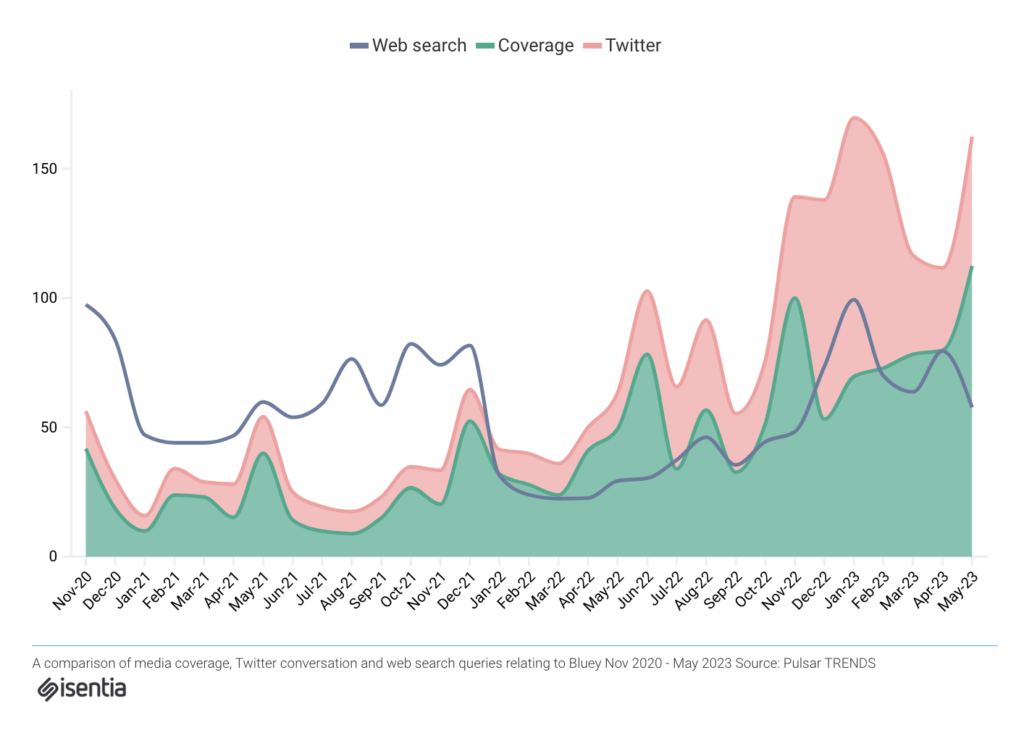
Drawing from the trajectory of Bluey, a children’s TV show that has captivated audiences across the globe, we delve into the realm of reputation management, unravelling the complexities that PR and communications professionals encounter in today’s dynamic landscape.
In today’s digital era, where people can freely share their opinions about a brand anytime and anywhere, maintaining a positive reputation means protecting your image and meeting the expectations of your audience, by staying aligned with the values of the communities you engage with.
Looking at four years of web search, online news coverage, and Twitter mentions, we uncover why this kids’ TV show, grounded in family values, has drawn widespread curiosity. Observing how audiences engage with Bluey content across social platforms, we can see a significant pattern emerging.
Amidst the limelight, how has Bluey navigated scandals and pitfalls while holding to the public’s high standards of family-friendly content? The power lies in understanding the needs, interests, and motivations of various community segments. Delving into these aspects, can help proactively sidestep the potential pitfalls encountered during brand reputation management and development, a lesson gleaned from Bluey’s journey.
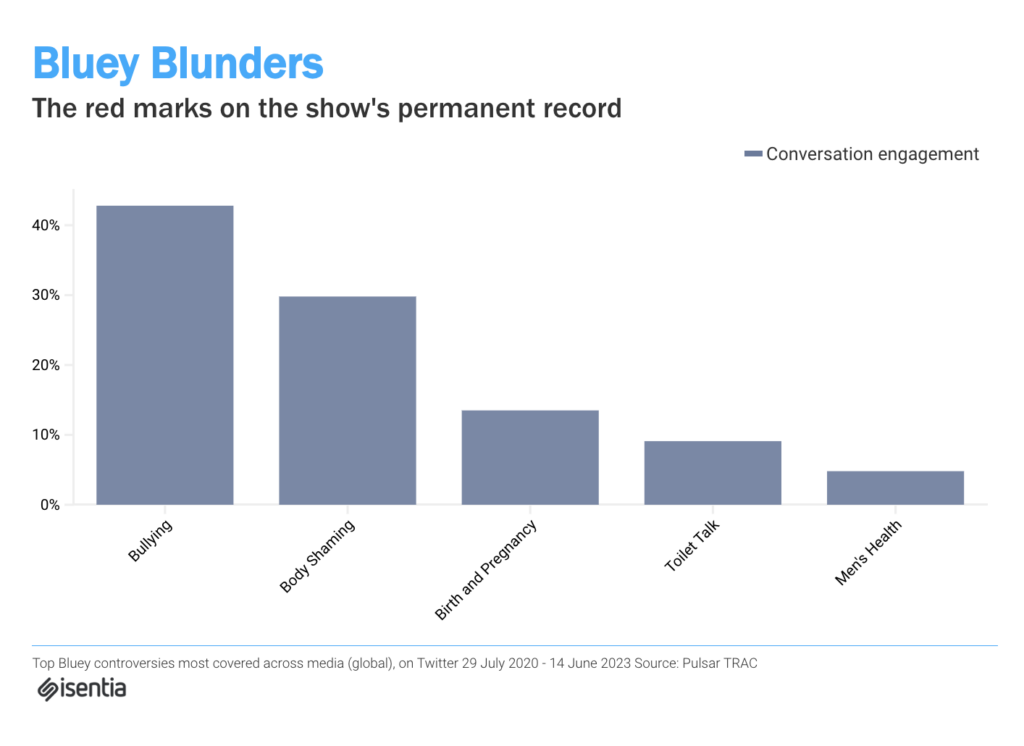
The program promotes education and emotional development through family-oriented activities, aligning with the brand image of family values in today’s world. However, some viewers have criticised the show for not representing a ‘“typical” modern family. As seen in the data above, some of the biggest blunders involve bullying, body shaming and whether it’s appropriate to mention sensitive issues around pregnancy, toilet talk, and men’s health concerns.
One specific incident being Chilli’s decision to pursue a career instead of being a full-time stay-at-home mum which was deemed as mum-shaming by some. The lack of same-sex marriages represented in the show, and its soft approach to disability have also been topics of contention for the show.
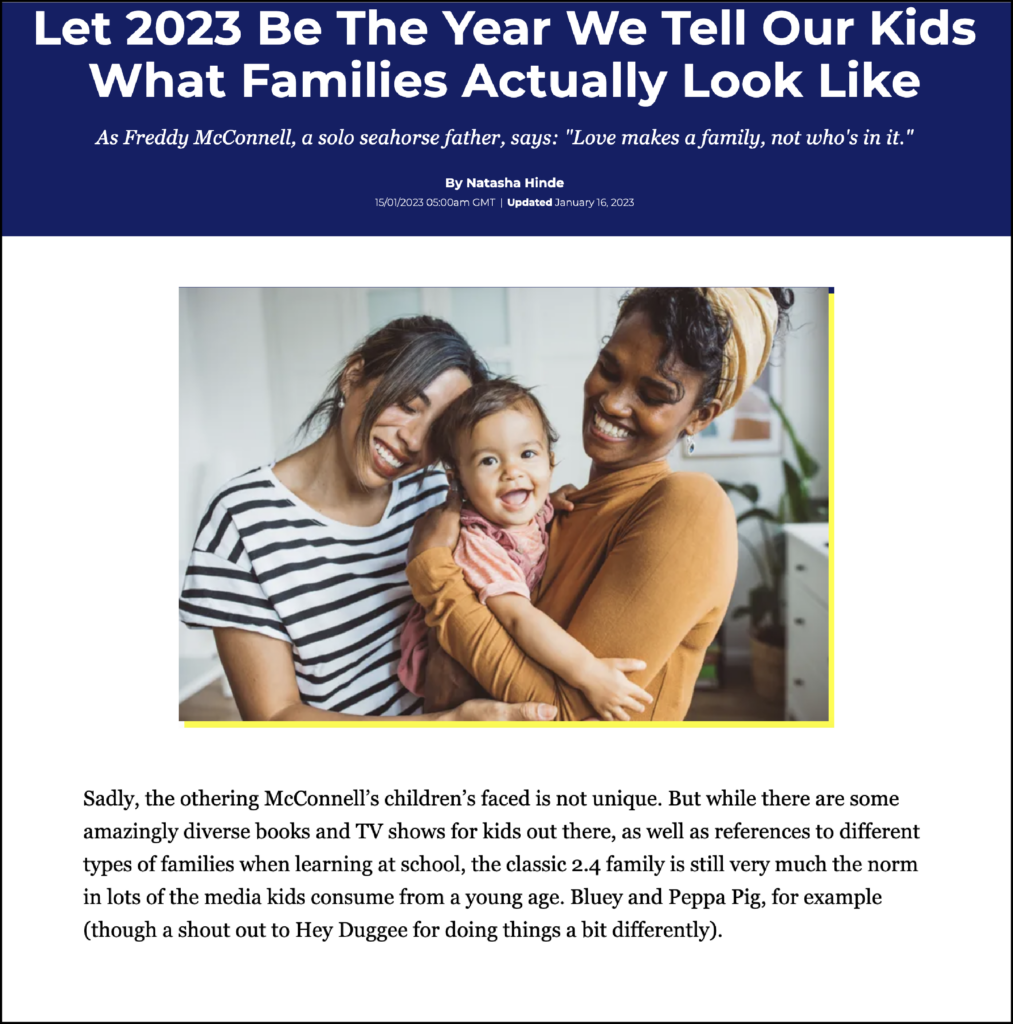
Fans have raised concerns about body shaming and the topics of vasectomies, premature births, and miscarriages. Some episodes distributed to the US, UK and even Australia have required editing or complete cancellation altogether, like the episode where the family jokingly uses the term “ooga booga”. The Macquarie Dictionary defines its meaning as “A stereotypical rendering of what the speaker regards to be the language of those deemed by them to be African savages.”
Gaining a profound comprehension of the audience and their values empowers brands to craft content that resonates, forming a robust bond with consumers. In an era where consumers readily scrutinise brands for authenticity, often challenging the sincerity of “purpose-driven communications”, this understanding becomes paramount. Such initiatives, without genuine action, risk being seen as mere gestures and unauthentic.
In the face of online scrutiny and media attention, as seen with Bluey’s occasional controversies, upholding the essence of an authentic family environment stands as a pivotal commitment. However, a question lingers – does Bluey accurately perceive the nuances of authenticity within the context of a contemporary 21st-century audience?
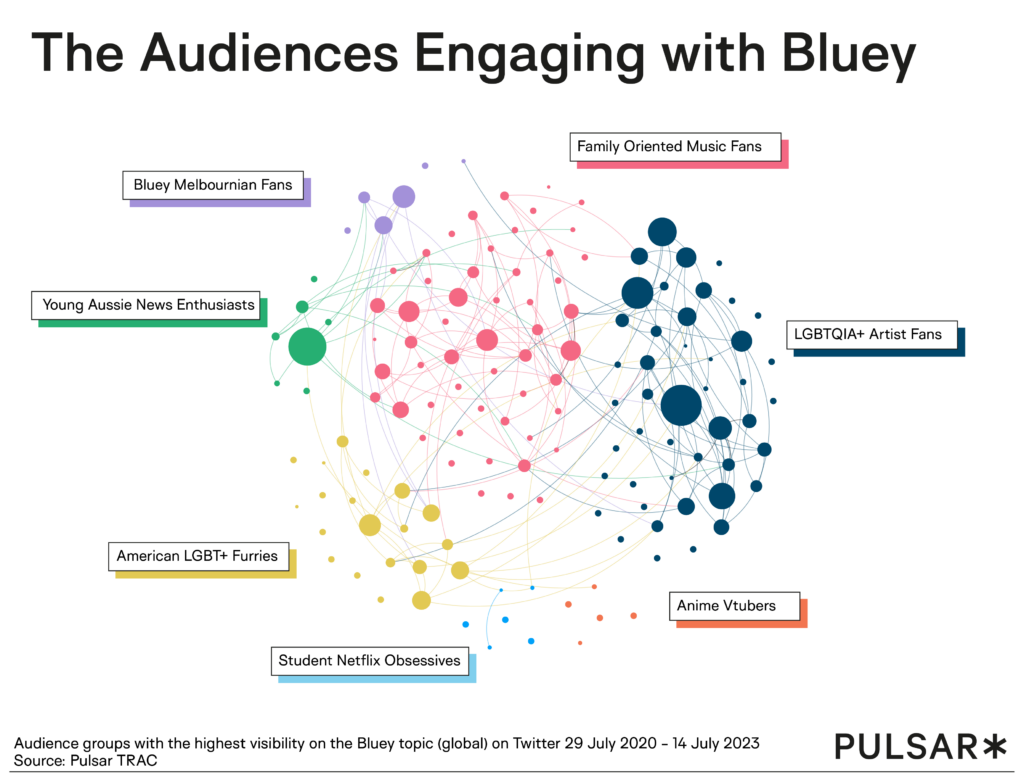
Utilising our sister company Pulsar’s audience intelligence platform, we can effectively identify the most active viewer groups within a conversation, like family-oriented music fans within the Bluey topic, and better understand how they integrate or fragment. This knowledge allows for timely and strategic responses to viewer discussions that may impact reputation.
It’s important to recognise that Bluey’s audience extends beyond just kids; parents and childfree adults are also avid viewers. However, these diverse communities hold varying values and connections that significantly shape the brand’s reputation. While Bluey’s focus is evidently on family and parenting, it also traverses through themes of relationships, self-image, representation, and emotional intelligence.
The crux lies in how these distinct groups engage with Bluey’s content and branding and then interpret and share their perspectives. This dynamic interaction places the reins of reputation management firmly in the hands (or paws) of the brand.
Among these communities, family-oriented fans resonate with Bluey’s adventures, sparking discussions that delve into the complexities of parenting. Their connection with the authentic family portrayal is a pivotal element.
On the other side, American LGBTQ+ furries advocate for inclusion and authenticity without gender labels. Young Australian news enthusiasts align themselves with events impacting the show, especially those related to censorship. Meanwhile, the Gen Z segment of student Netflix obsessives enthusiastically binge on the latest TV trends, underscoring the importance of staying current with zeitgeist fandoms.
By comprehending the priorities and dialogues of these diverse groups – as is the case with Bluey – messaging and content can be crafted to uphold positive brand reputation management from the audience’s vantage point.
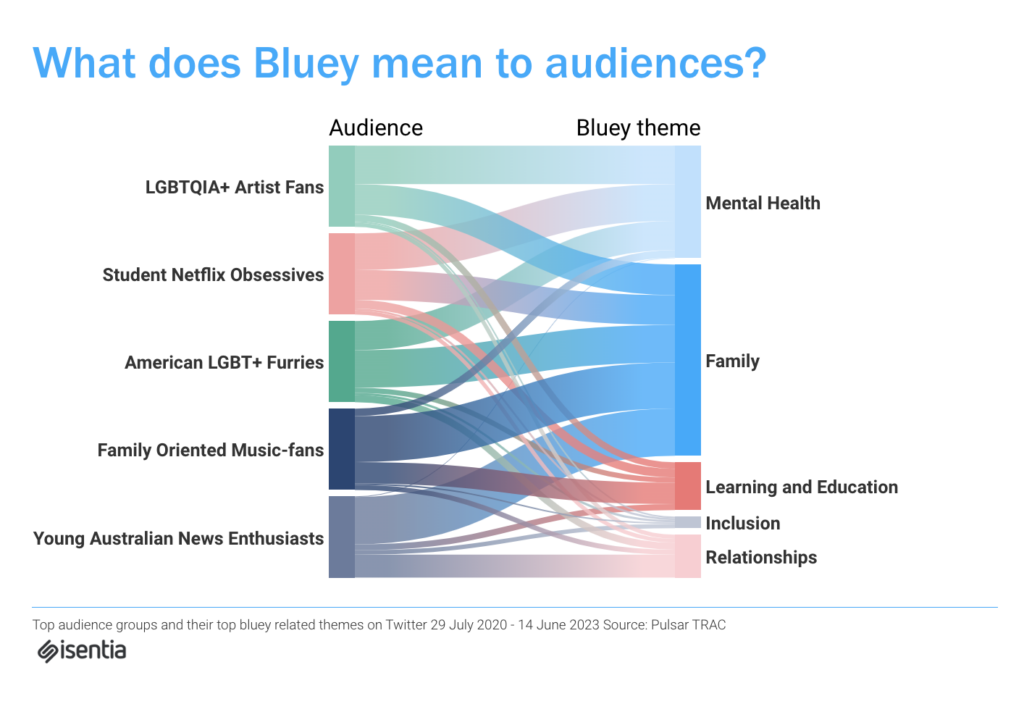
In the realm of modern public relations, brands are under growing pressure to embrace societal issues and adopt a meaningful purpose. This expectation extends even to children’s TV shows, adding a layer of viewer complexity to consider in messaging; the show’s messaging has to take into account all viewer group perceptions. And this gets more complex as more groups are identified and their perceptions are categorised.
Although family is the most significant theme for all the viewers listed on the chart above, different communities have distinct priorities. Fans of family-oriented music tend to focus on themes related to learning and education, while younger groups, LGBTQIA+ artists, student Netflix obsessives, prioritise mental health themes. By observing the ‘thickness’ or strength of the connection between audience and theme, we can see how the narrative flows into different audience types.
This prompts a crucial consideration: Is it appropriate to introduce weighty mental health themes to young minds and influence their formative years? While this inquiry is pertinent, it’s worth noting that some experts recommend that parents engage with such shows to gain valuable insights into these themes from a child’s perspective.
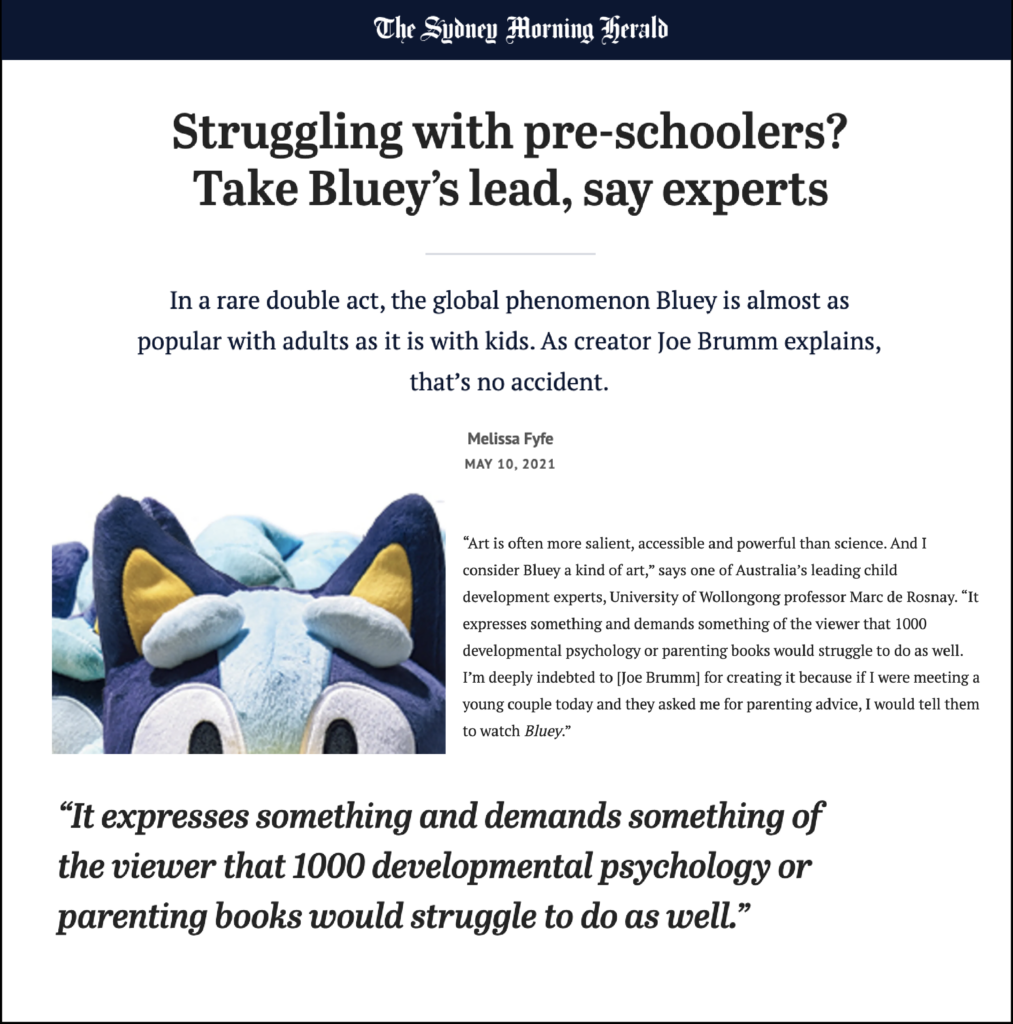
On the other hand, some adults use the show to heal from their own past traumas. While younger generations feel a sense of pride and responsibility when watching it with their younger family members.
Understanding varying perspectives presents a challenge and often carries significant weight in strategic PR decision-making, but by using research, we can observe differences and overlaps among different groups. How different communities engage and share bluey content, highlights the varying ways content can spread, and take on new meaning.
Although your community and stakeholders can influence your reputation, it’s important to remain proactive. In today’s digital age, brand values must be adaptable. For example, a scene from the “Exercise” episode was removed due to concerns from viewers, including single childless families, who felt that it could be viewed as fat-shaming and negatively impact viewers.
Additionally, an apology was issued after brand content was released that was seen by viewers as “mum-shaming” Chilli for not being able to spend as much time with her kids as a full-time stay-at-home mum. Viewers disagreed with the brand content’s judgmental and outdated portrayal of family roles.
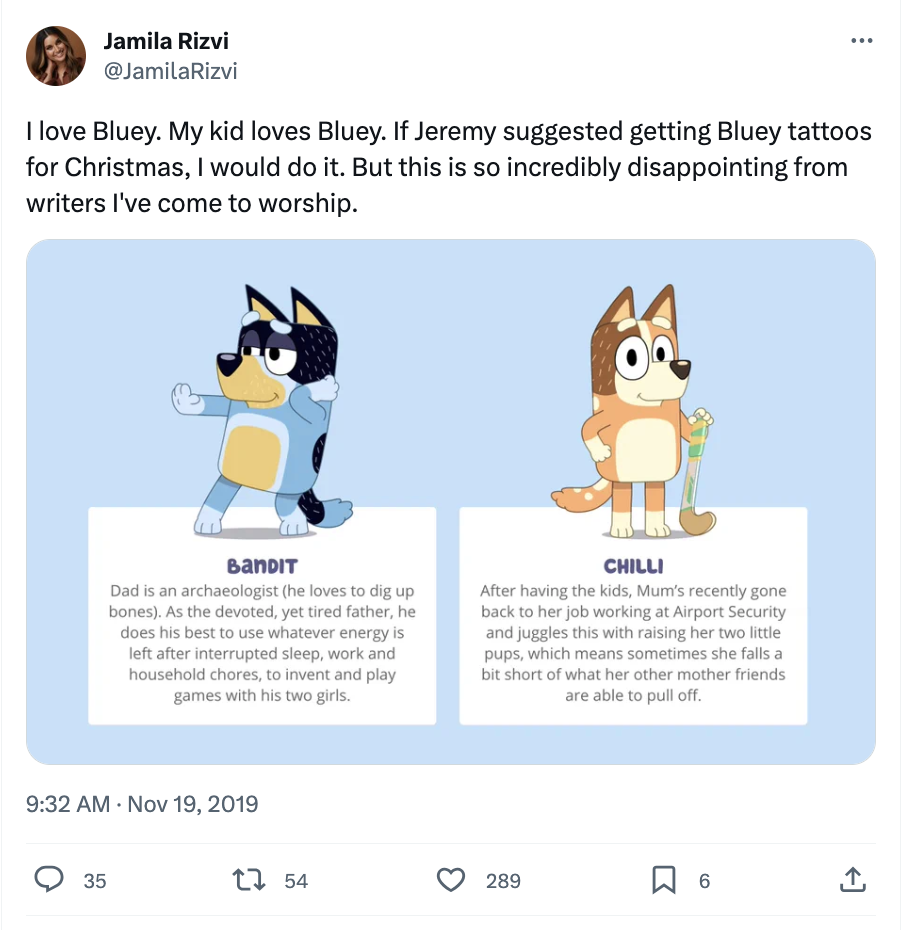
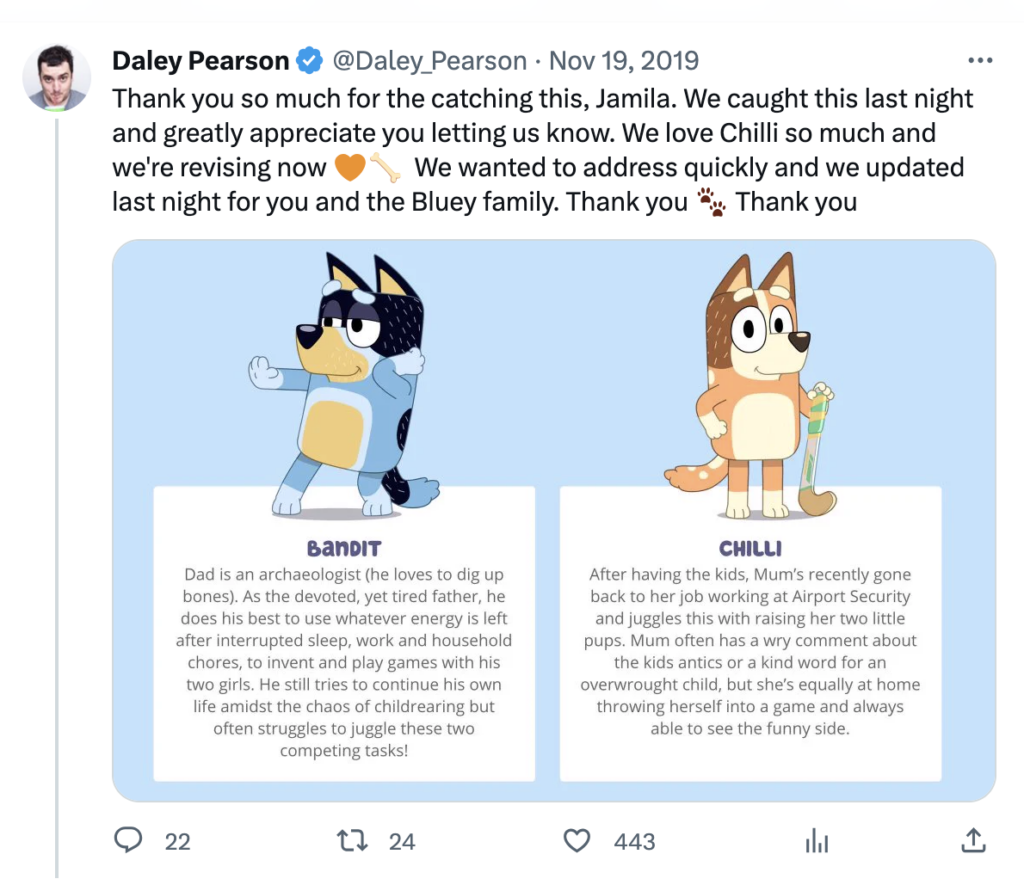
Converting reputation into numerical data makes it clearer and easier to understand and interpret as it’s based on input from the communities that shape it. The challenge for Bluey’s brand reputation management now is to accurately portray family life in today’s social climate and respond to feedback from everyday viewers.
In our constantly evolving world, the standards for children’s TV shows are shifting. A carefully planned reputation strategy is crucial for everyone impacted by fluctuating expectations. By analysing what your target stakeholders value and identifying how that’s projected onto your brand, we can measure what was previously unquantifiable.
Reach out to our team for advice on utilising research and monitoring solutions for their reputation management needs.
Loren is an experienced marketing professional who translates data and insights using Isentia solutions into trends and research, bringing clients closer to the benefits of audience intelligence. Loren thrives on introducing the groundbreaking ways in which data and insights can help a brand or organisation, enabling them to exceed their strategic objectives and goals.
Explore how BNPL is transforming consumer spending, financial strategies, and industry perceptions amidst regulatory and media scrutiny.
Explore how journalism shapes trust, audience engagement, and media influence in Australia and New Zealand.
Get in touch or request a demo.